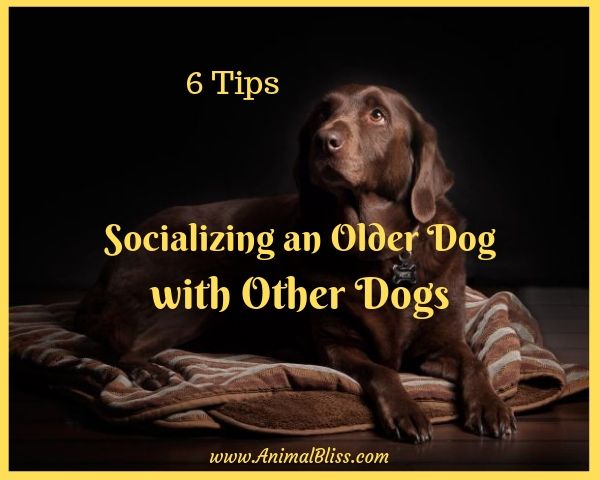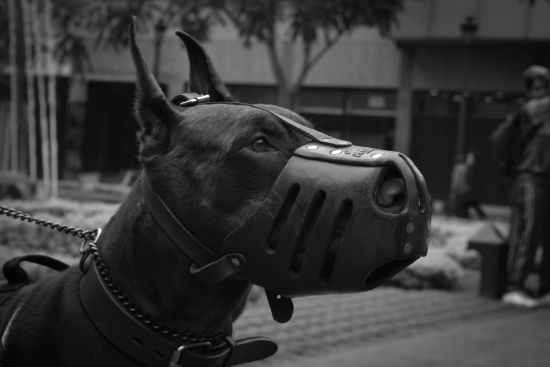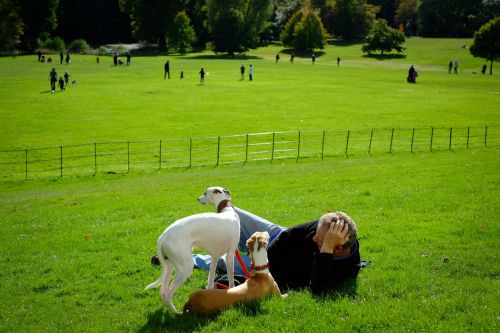Socializing an Older Dog with Other Dogs
Ideally, puppies have been socialized with a variety of experiences by the time they reach 12 weeks old. But sometimes, this is impossible, and then you need to learn how to train your dog. Socializing an older dog with other dogs can be trying at times and require a different approach than when socializing puppies.
Signs that your Dog is not Socialized
Socialization helps your dog react positively in unfamiliar environments. It prevents unwanted behavior, like jumping on, or nipping at people. Without it, dogs will behave anxiously or fearfully, which, in turn, leads to other behavioral problems like aggression. If you answer “yes” to any of the following questions, your dog may not be socialized.
- Is he afraid or aggressive towards people?
- Does he raise his hackles when approached?
- Is she nervous when out on a walk?
- Is she shy around others?
- Is he too excited by others, making them anxious?
Socializing an Older Dog with Other Dogs
Learning how to train your older dog varies depending on its age, breed, and temperament. You still need to expose your dog to new situations, and the following six tips will make that easier.
1. Use a Muzzle
Muzzling proves to be a controversial issue among pet owners, but sometimes it’s necessary. It is imperative with large breeds. Muzzles help prevent bad behavior like nipping, and they also help other people feel relaxed around your dog. When people are relaxed, dogs pick up on it and respond in kind. Read more about the pros and cons of wearing muzzles on this interesting article from Psychology Today.
2. Host a Dog Play Date
Don’t take your dog out to the park at once. Try organizing a small party with a maximum of 3-4 dogs at a time at first. Like us humans, each dog has its own unique personality. Make sure they are all similar in age, size, disposition, and styles of play. Try using an app like PatchPets, which allows you to check the other fluffy friend’s profiles. If you cannot find an app like this, joining some local Facebook groups is also a great idea.
3. Go on Walks Together
New experiences are a vital part of socializing an older dog. The exercise allows your dog to burn energy, which helps your dog remains calm. Try to avoid punishments if he starts to misbehave. Instead, use positive experiences and treats as a distraction.
Related:
The Benefits of Socialization for Your Dog – Some Good Advice
4. Work Up to the Dog Park
The dog park is the best environment for socializing your dog. However, when learning how to socialize an older dog with other dogs, you have to take it in stages. If you start with this, it may make matters worse. Start by incorporating the area around the dog park into your walks. Then, let your dog approach the fence to see and interact with other dogs.
Know what the do’s and don’ts when visiting a dog park. Always reward good behavior with treats. Deal with bad behavior by merely moving away. Consider using a social app for dogs to track your dog’s progress. Make notes of any particularly positive experiences or connections that form so that you can return to them later.
5. Introduce People One by One
Keep your dog on a lead and let your friends and family members approach slowly and speak softly. Giving them treats to offer your dog will also help. Make sure they avoid talking loudly or in a high-pitched voice. When dealing with strangers, give them a treat or favorite toy to pass on to your dog to help it form positive associations. If your dog reacts negatively, have the person slowly back away and try again later.
6. Keep Calm and Carry On
Whenever your dog begins to act frightened or anxious, you must not react harshly. Doing so will reinforce the fears your dog already has. Instead, remain calm and ignore the behavior where possible. The important thing is showing your dog that everything is okay, and there is no reason to be scared.
When socializing an older dog with other dogs, remember that the key factors are time and repetition. Do not worry if things do not go smoothly; it is okay if progress is slow. Just make sure that you are continuously supportive, calm, and loving while reinforcing that new experiences are positive things. Given time, everything will work out.
~~~~~
“6 Tips for Socializing an Older Dog with Other Dogs”
Guest Author Bio: Gigi Wara is a writer who loves covering and discovering topics about language and acquisition and education-related stories in general. She has written for many businesses since 2015. At his time, Gigi writes for PatchPets, Australia’s first social dog app designed to help dog owners socialize their furry friends with other dogs and dog owners. Connect to Gigi via Twitter.
*** Please Share ***
6 Tips for Socializing an Older Dog with Other Dogs Share on X![]()
MY QUESTION FOR YOU:
Have you had to train an old dog to correct certain behaviors? How did it go?
*** Leave your comment below. ***
(It’s just sexy!)

Peace
DISCLOSURE: Animal Bliss is a participant in the Amazon Services LLC Associates Program, an affiliate advertising program designed to provide a means for us to earn fees by linking to Amazon.com and affiliated sites.
(In other words, we’ll get a very small (teeny tiny) commission from purchases made through links on this website.)
So, go on … Don’t be shy!
Buy Something BIG and Expensive!
Buy a Jaguar. Or a Ferrari.
Thank you!
[amazon_link asins=’1607748916,1592533256,B0051H45GC,B073Z2FCTH,B07DR893TG,B07MHMHVKD’ template=’ProductGrid’ store=’animblis-20′ marketplace=’US’ link_id=’5ce58d31-91f0-4139-94c6-d92d945f58b5′]
- 4 Tips for Maintaining Healthy Weight for Your Cat - December 20, 2019
- 8 Amazing Benefits of CBD for Dogs and Other Pets - December 12, 2019
- Kibble or Canned Pet Food? What Should Your Pet Be Eating? - December 9, 2019





In general, most pets should have a complete physical check-up at least once per year. Always remember about this routine maintenance for your pet friends 🙂
Thanks for this article, is eye-opening. I’m Emily and I own two pets: a 2-year-old English bulldog named Roy and a 3-year-old cat named Lucy. Every weekend I always take my dog to my neighbour’s place to teach him how to socialize with other dogs, and this has really helped my dog a lot
Hi, Emily! Thanks for visiting my site. What a great thing it is to be able to give your pup a play date. It’s so important for them. All the best~!
Hey, loved your post.
One of my previous dogs was a “rescue dog” and had no social skills whatsoever.
I literally had to make dates for him with other no confidence dogs and he was getting better but unfortunately died before any real progress was made, so I totally understand!
Thanks for your visit to Animal Bliss, Michael. All the best.
I recall time one didn’t socialize there fur friends.
Coffee is on